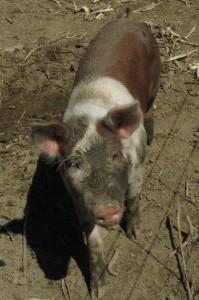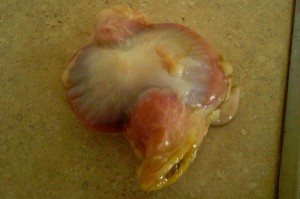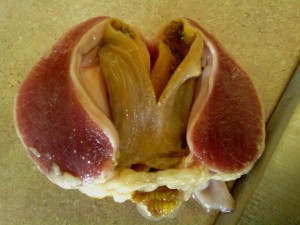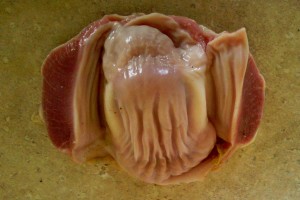My twelfth farm was Hamilton Farm and Barred Owl Creamery in Whitefield, Maine.
The Farm
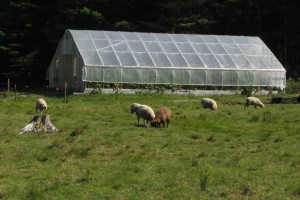 The farmers are Patti and Chris. Patti had always wanted to have a flock of sheep; she doesn’t know why. So in 1990, she and Chris bought a house with the intention of starting a little farm. They didn’t have space for sheep so they started with angora rabbits for fiber and some chickens. In 2000, they moved to their current 40 acre property in Whitefield. “Patti only takes animals that come her way,” Chris told me. Her first two milking goats came to the farm when their owner went away for a year and needed someone to look after them. Patti figured taking them was low risk since they came with everything she’d need to milk and care for them, and she’d be returning them at the end of a year. During the year, Patti found she really enjoyed milking the goats and making cheese. Luckily the owner didn’t want the goats back at the end of the year so they were Patti’s to keep. Finally, a person had sheep that needed a home. Patti got her sheep. Her sheep are dual purpose; they can be used for both meat and fiber. The farm is certified organic. In addition to the animals, there is an expansive and decorative vegetable garden.
The farmers are Patti and Chris. Patti had always wanted to have a flock of sheep; she doesn’t know why. So in 1990, she and Chris bought a house with the intention of starting a little farm. They didn’t have space for sheep so they started with angora rabbits for fiber and some chickens. In 2000, they moved to their current 40 acre property in Whitefield. “Patti only takes animals that come her way,” Chris told me. Her first two milking goats came to the farm when their owner went away for a year and needed someone to look after them. Patti figured taking them was low risk since they came with everything she’d need to milk and care for them, and she’d be returning them at the end of a year. During the year, Patti found she really enjoyed milking the goats and making cheese. Luckily the owner didn’t want the goats back at the end of the year so they were Patti’s to keep. Finally, a person had sheep that needed a home. Patti got her sheep. Her sheep are dual purpose; they can be used for both meat and fiber. The farm is certified organic. In addition to the animals, there is an expansive and decorative vegetable garden.
My Farming Experience
No one was home when I arrived in the late afternoon. In the distance I saw a Subaru Outback pulling a high trailer full of hay. A moment later Patti, my new host, was walking towards me. When she welcomed me with, “I need you to help put hay in the barn!” I knew this farm would be different from the others I’d been on. I followed her down to the barn and helped her, as much as my diminutive size would allow, move heavy, square bales of hay off the trailer so that John, the apprentice, could toss them up to Patti in the attic of the barn. This was my introduction to what one former WWOOFer called “The Hamilton Workout.”
The next morning Patti’s husband Chris mentioned that WWOOFers complain that Patti wears them out. As someone who prides herself on stamina, I vowed not to let that happen. I may not be mighty, but I can keep going.
Hamilton Farm is a homestead. They are living as sustainably as they can; growing their own food, raising animals,  canning. Patti is full of ideas and has many different things going on all at once. Consequently, I did a variety of tasks during my two weeks on the farm. Each day was something different. My first tasks were easy enough. I checked the recently foraged black trumpet mushrooms for bugs and debris. They grow plentifully in the area and look like tiny brown trumpets. Patti was dehydrating them and planned to sell them at the Common Ground Country Fair in a few weeks. She also added some of the mushrooms into meals she cooked. They added a nice woodsy flavor. My next tasks revealed my lack of knife skills. As a Trader Joe’s cook, my kitchen skills have been limited to turning on a microwave oven and stirring.
canning. Patti is full of ideas and has many different things going on all at once. Consequently, I did a variety of tasks during my two weeks on the farm. Each day was something different. My first tasks were easy enough. I checked the recently foraged black trumpet mushrooms for bugs and debris. They grow plentifully in the area and look like tiny brown trumpets. Patti was dehydrating them and planned to sell them at the Common Ground Country Fair in a few weeks. She also added some of the mushrooms into meals she cooked. They added a nice woodsy flavor. My next tasks revealed my lack of knife skills. As a Trader Joe’s cook, my kitchen skills have been limited to turning on a microwave oven and stirring.
A box of pears was put in front of me. I needed to peel them. I slowly worked slicing off the skins and sometimes taking  off too much fruit. At one point Patti came by and watched my poor technique. She demonstrated peeling with the knife moving towards her thumb. I was sure I’d take off part of my thumb, but I was excited to learn a new knife skill. A few days later I was assigned the task of chopping tomatoes for canning. I knew there was a quick way to do it, but I didn’t know what that quick way was. I nervously chopped the tomatoes into small pieces hoping I could get them done before Patti came back into the kitchen. As I was nearing the end, Patti walked in to check on the tomatoes. In my focus on cutting the tomatoes, I’d neglected to notice that their juice had run down the side of the counter. Patti opened the drawers and found it had seeped inside. I felt like a small child. I also had been cutting the tomatoes too small. She showed me how she wanted them cut into large pieces and commented that it shouldn’t be taking me so long to get this done. Later over lunch I mentioned that I hoped I could work outside with the peas in the afternoon because the kitchen made me nervous. Thankfully, Patti laughed and sent me to plant peas.
off too much fruit. At one point Patti came by and watched my poor technique. She demonstrated peeling with the knife moving towards her thumb. I was sure I’d take off part of my thumb, but I was excited to learn a new knife skill. A few days later I was assigned the task of chopping tomatoes for canning. I knew there was a quick way to do it, but I didn’t know what that quick way was. I nervously chopped the tomatoes into small pieces hoping I could get them done before Patti came back into the kitchen. As I was nearing the end, Patti walked in to check on the tomatoes. In my focus on cutting the tomatoes, I’d neglected to notice that their juice had run down the side of the counter. Patti opened the drawers and found it had seeped inside. I felt like a small child. I also had been cutting the tomatoes too small. She showed me how she wanted them cut into large pieces and commented that it shouldn’t be taking me so long to get this done. Later over lunch I mentioned that I hoped I could work outside with the peas in the afternoon because the kitchen made me nervous. Thankfully, Patti laughed and sent me to plant peas.
There was a menagerie of animals on the farm. The main four were two sheep and two goats that were milked to make cheese. I watched John hand-milk them a few times. Milking goats is easy: their teats hang straight down towards the pail. Sheep, on the other hand, have teats that point more horizontally, which I think from a baby animal’s perspective makes more sense. From a hand-milker’s perspective, it’s a pain in the neck. John used one hand to massage the udder to get the milk to flow, and squeezed the teat with the other. Luckily for John, neither sheep had a lot of milk since it was a slow, one side at a time milking routine. The rest of the menagerie were a flock of sheep used for wool and meat, a few baby goats with a surrogate mom named Gurty, two pigs that seemed somewhat sweet, a flock of turkeys that paraded down the ramp of their shed each morning, and a bunch of chickens. My main interaction with the animals was finding baby goats nibbling in the vegetable garden and chasing them out.
Patti makes cheese using a blend of the sheep and goat’s milk. I thought it had a richer flavor than a goat’s milk-only cheese. She makes a chevre and a blue cheese under the name Barred Owl Creamery.
Right before I arrived on the farm, fifty chickens were sent off to the slaughter house. They returned a few days later with their parts sorted into bags. My job for an afternoon was to clean fifty gizzards and package them with the necks so they’d be ready to make soup stock. Cleaning a gizzard is rather fun. I peeled off the white blobby fat that clung around the gizzard. Then I took a knife and slid it through the side, just like opening a clam. I used my thumbs to pry open the gizzard and peel out the green lining that held the grass and sand that was used for digestion. I gave it a good rinse, and voila, a clean gizzard.
Patti had a wonderfully productive and decorative vegetable garden. Lettuces grew in large circles, and the 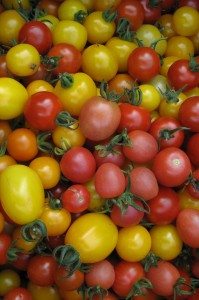 corn dominated the hillside. I did not see a bug bite on any of the plants. Maybe I didn’t look closely enough, but the plants looked amazing. Patti wouldn’t reveal her secretes. I spent a lot of time working in the gardens: weeding, preparing the beds and planting peas, planting seeds in the green house, and harvesting. I spent a long afternoon picking tomatoes in the greenhouse. The cherry tomatoes were as good as candy. They had me thinking of becoming a cherry tomato farmer. My least favorite vegetable to harvest is the green bean. How can you find something that is hanging low to the ground and is the same color as the foliage around it? “You need to be like Nancy Drew,” Patti remarked after finding that I’d missed a large number of beans. So I sleuthed through the lines of green on the lookout to find every bean.
corn dominated the hillside. I did not see a bug bite on any of the plants. Maybe I didn’t look closely enough, but the plants looked amazing. Patti wouldn’t reveal her secretes. I spent a lot of time working in the gardens: weeding, preparing the beds and planting peas, planting seeds in the green house, and harvesting. I spent a long afternoon picking tomatoes in the greenhouse. The cherry tomatoes were as good as candy. They had me thinking of becoming a cherry tomato farmer. My least favorite vegetable to harvest is the green bean. How can you find something that is hanging low to the ground and is the same color as the foliage around it? “You need to be like Nancy Drew,” Patti remarked after finding that I’d missed a large number of beans. So I sleuthed through the lines of green on the lookout to find every bean.
I went on my first successful mushroom hunt when Patti took me with her to collect black trumpets. These mushrooms are easily identifiable because of their unique shape. Patti showed me that they grow in clusters, so if I found one, there would be many more right in that area. I could spend five or ten minutes collecting in one small area. We filled three large baskets before heading back home.
The work hours on the farm were long. At six in the morning I met with Patti to get my first task of the day. I finished working around seven or eight in the evening with only a break to eat breakfast and lunch. Most of the time, I worked alone. Even with the long hours, I hadn’t gotten worn out. That just wasn’t going to happen.
Patti had just started listing her small cabin on Air B&B, and on most days there were guests. The first guests I met pulled up just minutes after I arrived at the farm. I’d noticed a cabin structure with a road that led down to it. I thought I was being helpful telling the couple from the Hudson Valley that it was their cabin for the night. They walked over to it and stood for a time looking at it with their hands on their hips. It wasn’t until a couple of days later that I discovered I’d sent them to the chicken coop. Nevertheless, I got to meet them and all the other guests over Patti’s blueberry pancakes in the morning and at Chris’s campfire circle in the evening. I found the guests interesting and liked the extra energy they added to my stay on the farm.
Chris likes to draw maps and give advice to tourists. On my first day off he recommended I go to the coast at Rockland.  The drive through the open Maine countryside was lovely. At Rockland, I visited Project Puffin where I learned about one man’s passion to bring puffin colonies back to Eastern Egg Rock. Over and over during my travels WWOOFing I’ve learned about the changes a single person has made through their dedication to a cause. After a walk along the breakwater to a lighthouse, I continued driving up the coast to Camden, a town which reminded me of Scotland. For my other day off, Chris recommended I take the ferry to Vinalhaven, an island off the coast of Rockland that Chris said had the quintessential Maine coastline of rugged granite rocks. The island was one of the main sources of quality granite during the eighteen and early nineteenth century. The Washington Monument and Brooklyn Bridge were made from it, along with most federal buildings that were built during that period. Today the sunken quarries are used as swimming holes, the water being a more pleasant temperature than the northern Atlantic. Lobster fishing is how most families on the island make a living. I was there on a perfect summer day. Everything shone with beautiful colors: the blue of the harbor and sky, the whites of the sails, the reds of the lobster cages, the greens of the plants, and the multi-colors of the flowers. It was peaceful and quiet; the kind of place one would like to settle into for a while. I only had a couple of hours to explore the island before the last ferry of
The drive through the open Maine countryside was lovely. At Rockland, I visited Project Puffin where I learned about one man’s passion to bring puffin colonies back to Eastern Egg Rock. Over and over during my travels WWOOFing I’ve learned about the changes a single person has made through their dedication to a cause. After a walk along the breakwater to a lighthouse, I continued driving up the coast to Camden, a town which reminded me of Scotland. For my other day off, Chris recommended I take the ferry to Vinalhaven, an island off the coast of Rockland that Chris said had the quintessential Maine coastline of rugged granite rocks. The island was one of the main sources of quality granite during the eighteen and early nineteenth century. The Washington Monument and Brooklyn Bridge were made from it, along with most federal buildings that were built during that period. Today the sunken quarries are used as swimming holes, the water being a more pleasant temperature than the northern Atlantic. Lobster fishing is how most families on the island make a living. I was there on a perfect summer day. Everything shone with beautiful colors: the blue of the harbor and sky, the whites of the sails, the reds of the lobster cages, the greens of the plants, and the multi-colors of the flowers. It was peaceful and quiet; the kind of place one would like to settle into for a while. I only had a couple of hours to explore the island before the last ferry of  the day returned to Rockland. I walked to the coastal viewpoint Chris had recommended. Off in the distance was the wide open Atlantic. My birthday hit on a day Chris was going into Portland. I was given the afternoon off so I could catch a ride with him. Now that I’m into knitting, I had to go to Port Fiber to check out what they had. The store focuses on spinning, so it carried a large selection of roving and even had drop spindles–exactly what I was looking for. With my birthday presents to myself in tow, I strolled around the waterfront and downtown area waiting for Chris to finish his meeting. He treated me to a birthday dinner where we sat outside overlooking the harbor. It was a memorable birthday.
the day returned to Rockland. I walked to the coastal viewpoint Chris had recommended. Off in the distance was the wide open Atlantic. My birthday hit on a day Chris was going into Portland. I was given the afternoon off so I could catch a ride with him. Now that I’m into knitting, I had to go to Port Fiber to check out what they had. The store focuses on spinning, so it carried a large selection of roving and even had drop spindles–exactly what I was looking for. With my birthday presents to myself in tow, I strolled around the waterfront and downtown area waiting for Chris to finish his meeting. He treated me to a birthday dinner where we sat outside overlooking the harbor. It was a memorable birthday.
My last day on the farm started with weeding the rows between the potato beds. I used a fork to heave out the stubborn grass. “Ha! It’s my last day and she’s not going to wear me out,” I thought to myself feeling satisfied. As the morning wore on, John and his girlfriend Lauren finished their row and left for other responsibilities. I had the rest of the beds to finish myself. The sun was bright in the sky and the temperature was pleasant. I started sweating. I continued breaking up the ground and throwing the weeds over the fence to a few waiting sheep. Then it started to happen: I was getting worn out. No matter how tired I got I was going to make it through the day and finish any tasks I was given. “Hey, why don’t you work on the front garden? You can finish pulling up the grass that you started the other day,” Patti called from the house. Popping out the sod with a shovel had been fun the other day. Now I just wanted to get it done before I toppled over. I completed the weeding and removed all the sod to create a new design in the garden. The front yard looked transformed by the changes. I slowly made the long walk up the street to put the tools away in the shed. Patti had worn me out. I couldn’t believe it.

